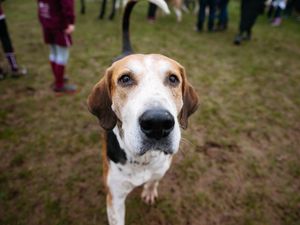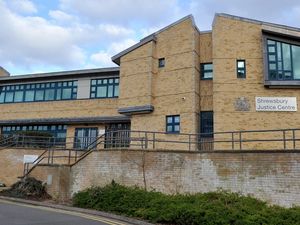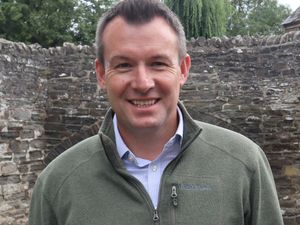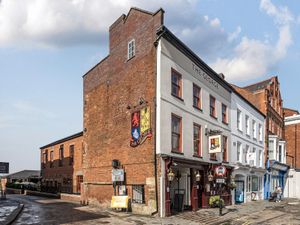Pure joy at Shropshire Hoard find in Bitterley
Unearthing the Bitterley Hoard represented a moment of 'pure joy and excitement' for Shropshire antiquities expert Peter Reavill.
Unearthing the
represented a moment of 'pure joy and excitement' for Shropshire antiquities expert Peter Reavill.
Mr Reavill was alerted to a farmer's field in Bitterley by retired engineer Howard Murphy, 66, of Ludlow, after he had found a silver coin. Remarkably, Mr Murphy resisted the temptation to unearth a pot stuffed with silver and gold coins, deciding to leave it to the experts.
Mr Reavill said: "I can't speak highly enough of Mr Murphy. He did exactly the right thing. Instead of trying to unearth the pot of coins, he left them in the ground.
"That meant the site was left intact so that archaeologists could do their work. It helped because we were able to recover the pot without any significant damage.
"We were also able to examine the site to see whether there were more clues as to who left the coins there – and why.
"It is pure speculation, of course, as to why they were left there. They could have been placed there by a soldier from the Civil War or they could have been left there by an elderly man who didn't want people to get his money. There are a number of theories."
Mr Murphy and Mr Reavill had met prior to the discovery of the Bitterley Hoard, when Mr Murphy attended one of Mr Reavill's courses about practical ways in which archaeological sites could be interrogated.
Ruffle
Mr Reavill said: "The first I heard about this find was a phone call late one evening in February – it was from Howard – he said 'I've found a hoard – a pot full of silver coins – and I've left it in the ground for you'. Howard is from Yorkshire and it takes a bit to ruffle his feathers – but there was a quiver in his voice – he was worried – had he done the right thing?
"We arranged for me to go out to the site over the weekend and have a look. We were both concerned that if we left it someone else would come and take it away, but the find spot was thankfully well off the beaten track and out of sight of prying eyes."
When the two men – and another expert, Tom Brindle – visited the site, they backfilled the hole and made the site look as undisturbed as possible; even moving a large number of mole hills to blend the find spot with the surrounding field.
Mr Reavill said: "The find was made on land under semi-permanent pasture. We also had no idea of the size of the hoard – whether there were just 20 coins or many more. The only way to find this out was to dig it up – and so we arranged a full rescue excavation."
The men returned a few days later to dig.
"When we got to the site; it was clear that no-one else had found it and the hoard was still safely in place – the first stage was to record the hole that Howard had dug," he said.
The men then cut a larger trench with the hoard at the centre. Mr Reavill added: "We cleared the turf and topsoil cleaning the soil back at a layer just above the hoard. We were looking for any traces of a pit or other archaeology present, especially changes in colour and texture in the soil."
Successive holes were cut around the coin-filled pot to see whether there was evidence of settlement, though no further clues were found.
Mr Reavill said: "With no other buried archaeology present we decided to lift the hoard in a single block – this is always a worrying operation as we knew the size at the top – but not the base – so the soil was removed to leave a single column of soil and excavated to a depth well below the natural. It was then supported with cling film and bandages – and then slowly undermined.
Packed
"Luckily the soil was wet and solid and the block stayed in one piece, coming from the ground after more than 300 years. It was packed up in a box and taken to the museum in Ludlow.
"The hoard itself was kept refrigerated in an old fridge from the staff room to inhibit the growth of mould and to stop the surrounding soil drying and cracking. We had no idea what was inside and museum colleagues had to find somewhere else to store their milk and packed lunches."
The team had to wait several months before the hoard could be taken to London and the staff at the Conservation and Research Department at the British Museum could work on it.
The hoard was sent to the British Museum so that it could be examined by expert Pippa Pierce and her colleagues. It was excavated from its clay block and over time the container and the coins within were revealed.
Experts wanted to know whether the coins at the top were more recent than those at the bottom, which might have given them clues as to why they were there.
Mr Reavill added: "The excavation showed that there was no difference between the layers and that they had been thoroughly mixed before deposition. What was interesting was that it seems as if the coins were placed in the vessel in small stacks or columns and several groups of coins were removed in this way.
"In total there were 138 coins all of high denomination – many were very well preserved." The container in which the coins were stored was revealed to be a local 'blackware' vessel, called a tyg. Inside the tyg was a leather purse. Mr Reavill added: "The leather was very fragile. Its survival was rare as leather and other organic materials seldom survive in the soil. If the finder had dug the hoard himself it is likely that this unique element would have been severally damaged or lost as it is so fragile."
The coins were then removed and analysed by Dr Barrie Cook and Henry Flynn of the Department of Coins and Medals at the British Museum.
The hoard has now been declared Treasure under the 1996 Act and will be valued by the independent Treasure Valuation Committee. Once a market value has been established and agreed upon – Shropshire Museums hopes to obtain grant funding and local contributions so that it can acquire the hoard. The farmer and Mr Murphy will receive a reward.
Councillor Mike Owen, cabinet member for tourism and culture at Shropshire Council, added: "This hoard has thrown light on a dark and turbulent period of our relatively recent history.
"Like all hoards of this nature we ask the question why was such a large amount of money left in the ground and never retrieved."
Time
It will be some time before a precise value is established, but Richard Varnham, a coins expert from www.coinsforsale.co.uk, believes a figure up to £30,000 is possible.
He said: "There are many variables involved when estimating the value of coins, principally their condition. However, it is possible to estimate approximate values, based on the sums that similar coins fetch at auction."
Mr Varnham said an Edward VI, silver shilling, was likely to have a value of about £100 while 46 Elizabeth I silver shillings were each likely to be valued at about £225, giving a total of £10,350 for the Edward VI and Elizabeth I set.
A James I, gold crown was likely to be worth about £1,500 while four silver half-crowns were probably worth about £500 each and 20 shillings were likely to have a value of £100; giving the James I set a value of approximately £5,500.
Mr Varnham added that a collection of Charles I, Tower mint, silver half-crowns were valued at around £250, while half-crowns were about £50. A Charles I, provincial mint, silver half-crown was likely to be £500, while silver Charles I Scottish coins were likely to generate around £100 per shilling and £50 per half shilling. The total value for the Charles I selection was about £13,050.
Mr Reavill added that the discovery, reporting, excavation, investigation and analysis of the hoard had taken over a year.
He said: "In that time a detailed picture has evolved which has shed new light on events that happened more than 300 years ago. Coin hoards from the Civil War are relatively common with several known for each county in Britain; so many hoards show the upheaval and underlying worry of the general population. This urgency and unrest can be seen in Bitterley Hoard – where the only direct archaeological evidence for the placing of the hoard in the ground – is the hoard itself. The excavation showed that the burying of the hoard was relatively quick – in a prepared container.
"The local events that caused the hoard to be buried are unknown but the fact that they were never retrieved suggests that something happened to the owner and unfortunately their loss has been our gain."
Mr Reavill is keen that the coins go on display in Shropshire so that the general public can enjoy the collection that was unearthed.
He added:?"It's an amazing collection and my big hope is that it goes on permanent display. We're not quite at that stage yet but hopefully, by making the public aware of the hoard, we can plant a seed with people. We will probably need public support if we try to fundraise to acquire the hoard and so it's our greatest wish that people look favourably on our work so that the coins can go on display."
By Andy Richardson




